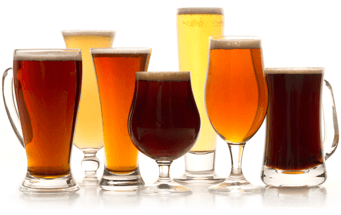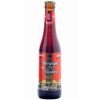Brouwerij Timmermans - Bourgogne des Flandres
-
ABV:
5.0% -
Bottle Size:
330-ml -
Serving Temperature:
45-50° F -
Suggested Glassware:
Tulip, Chalice, or Flute
Note: Even if you usually like drinking from the bottle, this is a style that truly requires a glass, like a wine. In fact, Bourgogne des Flandres means “Burgundy of Flanders”, and the comparison to wine is appropriate as Flanders Red Ales and Oud Bruins are often considered the most wine-like of beers due to their prominent acidity and complex fruity notes, and this brew is no exception. (To us, this beer seems to straddle the related Flanders/Flemish Red and Oud Bruin styles, and the brewery itself refers to it by both red and brown terms in different places, so we won’t obsess over trying to put it in a specific box.)
On the pour, expect quite a dark brown hue with reddish highlights topped with a robust crop of foam. Fruity notes abound on the nose; look for a somewhat candied cherry and apple character with touches of cola, grape skin, and port wine. We got notes of caramel and hints of brown bread, along with an ever-so-slight vinous acidic impression and a lightly phenolic, spicy edge. On the palate things get even more interesting as the beer opens with a pronounced sweetness, but remarkably the lambic tartness begins immediately to envelop the beer, starting at the sides of the tongue and building until the sweetness is balanced out and even overshadowed. Expect prominent fruity esters along with hints of oak and light sherry-like oxidation notes from its extended stay in barrels. The brewery recommends serving at about 40° F, but we really prefer this style much less cold. This writer prefers 50-55° F, but try it at different temps and see what you prefer, or start cold and let it warm in your glass as you drink. Try pairing this brew with red meat – especially game – perhaps with a fruit reduction sauce. Roquefort and Camembert are excellent too. Cheers!
Timmermans proudly claims the title of the world's oldest lambic brewery, dating back to 1702. Lambic is a style of spontaneously-fermented beer that is brewed exclusively in the Zenne valley within a 15-km radius of the center of Brussels, Belgium. What makes lambic so unique is that the beer is not inoculated with standard Saccharomyces cerevisiae brewer’s yeast like most other beers; instead, the beer is exposed to the local air, picking up wild Brettanomyces lambicus and Brettanomyces bruxellensis yeasts which ferment the beer naturally and lend acidity, sourness, and what we beer geeks refer to very scientifically as “funk.” Some lambics are enjoyed young and fresh while others are aged for up to three years or longer. Additionally, many lambics are brewed with fruit, usually cherry (kriek), raspberry (framboise), or peach (pêche), which creates a wholly unique drinking experience.
Spontaneous fermentation is the oldest form of brewing, and lambic, specifically, has been produced in Belgium at least as far back as the 1200s. Around 300 lambic breweries were in operation in 1900, but today there are fewer than a dozen brewers keeping this traditional style alive—although with the growing worldwide craft beer renaissance, the interest and demand for lambic is growing stronger and stronger. Sour ales, inspired by traditional lambic, are being produced in ever-increasing amounts by brewers here in the U.S. as well as in various countries overseas, so the future looks quite bright for this ancient style of beer.
Timmermans can trace its roots back to 1702 when what was known at the time as the Mole Brewery was founded in Itterbeek, not too far from the center of Brussels. Owned by Jan Vandermeulen, the property also included a cafe, malt-house, orchard, and farm. During the 19th century, the brewery produced beer to meet the requirements of the stagecoach relay station, where horses were changed and travelers could grab some food and drink before heading on their way.
The brewery came into the hands of the Timmermans family in 1911 when Gerardus Franciscus Timmermans and his wife, Celina, inherited the property from Celina's family. Not long after, the orchard, farm, and relay were shut down so full attention could be paid to the brewery. In 1985, Timmermans took over the brewing of Bourgogne des Flandres, a recipe of the Van Houtryve family whose brewing legacy in Bruges dates back to 1765. To learn more about Timmermans, visit them at brtimmermans.be/en, and to see more about Bourgogne des Flandres, check out their dedicated site at www.bourgognedesflandres.be/en.

Unmatched Variety by style, brewery & country
Choose from Five different Beer Clubs offering unmatched variety by brewery,
country of origin, and beer style to suit your specific tastes.


